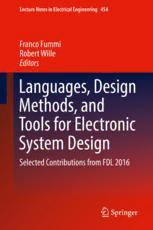
Languages, Design Methods, and Tools for Electronic System Design: Selected Contributions from FDL 2016 PDF
Preview Languages, Design Methods, and Tools for Electronic System Design: Selected Contributions from FDL 2016
Lecture Notes in Electrical Engineering 454 Franco Fummi Robert Wille Editors Languages, Design Methods, and Tools for Electronic System Design Selected Contributions from FDL 2016 Lecture Notes in Electrical Engineering Volume 454 BoardofSerieseditors LeopoldoAngrisani,Napoli,Italy MarcoArteaga,Coyoacán,México SamarjitChakraborty,München,Germany JimingChen,Hangzhou,P.R.China TanKayChen,Singapore,Singapore RüdigerDillmann,Karlsruhe,Germany HaibinDuan,Beijing,China GianluigiFerrari,Parma,Italy ManuelFerre,Madrid,Spain SandraHirche,München,Germany FaryarJabbari,Irvine,USA JanuszKacprzyk,Warsaw,Poland AlaaKhamis,NewCairoCity,Egypt TorstenKroeger,Stanford,USA TanCherMing,Singapore,Singapore WolfgangMinker,Ulm,Germany PradeepMisra,Dayton,USA SebastianMöller,Berlin,Germany SubhasMukhopadyay,Palmerston,NewZealand Cun-ZhengNing,Tempe,USA ToyoakiNishida,Sakyo-ku,Japan BijayaKetanPanigrahi,NewDelhi,India FedericaPascucci,Roma,Italy TariqSamad,Minneapolis,USA GanWoonSeng,NanyangAvenue,Singapore GermanoVeiga,Porto,Portugal HaitaoWu,Beijing,China JunjieJamesZhang,Charlotte,USA AboutthisSeries “Lecture Notes in Electrical Engineering (LNEE)” is a book series which reports thelatestresearchanddevelopmentsinElectricalEngineering,namely: (cid:2) Communication,Networks,andInformationTheory (cid:2) ComputerEngineering (cid:2) Signal,Image,SpeechandInformationProcessing (cid:2) CircuitsandSystems (cid:2) Bioengineering LNEE publishes authored monographs and contributed volumes which present cuttingedge research information as well as new perspectives on classical fields, while maintaining Springer’s high standards of academic excellence. Also consideredforpublication are lecture materials, proceedings, and other related materials of exceptionally high quality and interest. The subject matter should be original and timely, reporting the latest research and developments in all areas of electricalengineering. The audience for the books in LNEE consists of advanced level students, researchers,andindustryprofessionalsworkingattheforefrontoftheirfields.Much like Springer’s other Lecture Notes series, LNEE will be distributed through Springer’sprintandelectronicpublishingchannels. Moreinformationaboutthisseriesathttp://www.springer.com/series/7818 Franco Fummi (cid:129) Robert Wille Editors Languages, Design Methods, and Tools for Electronic System Design Selected Contributions from FDL 2016 123 Editors FrancoFummi RobertWille UniversityofVerona JohannesKeplerUniversityLinz Verona,Italy Linz,Austria ISSN1876-1100 ISSN1876-1119 (electronic) LectureNotesinElectricalEngineering ISBN978-3-319-62919-3 ISBN978-3-319-62920-9 (eBook) DOI10.1007/978-3-319-62920-9 LibraryofCongressControlNumber:2017950291 ©SpringerInternationalPublishingAG2018 Thisworkissubjecttocopyright.AllrightsarereservedbythePublisher,whetherthewholeorpartof thematerialisconcerned,specificallytherightsoftranslation,reprinting,reuseofillustrations,recitation, broadcasting,reproductiononmicrofilmsorinanyotherphysicalway,andtransmissionorinformation storageandretrieval,electronicadaptation,computersoftware,orbysimilarordissimilarmethodology nowknownorhereafterdeveloped. Theuseofgeneraldescriptivenames,registerednames,trademarks,servicemarks,etc.inthispublication doesnotimply,evenintheabsenceofaspecificstatement,thatsuchnamesareexemptfromtherelevant protectivelawsandregulationsandthereforefreeforgeneraluse. Thepublisher,theauthorsandtheeditorsaresafetoassumethattheadviceandinformationinthisbook arebelievedtobetrueandaccurateatthedateofpublication.Neitherthepublishernortheauthorsor theeditorsgiveawarranty,expressorimplied,withrespecttothematerialcontainedhereinorforany errorsoromissionsthatmayhavebeenmade.Thepublisherremainsneutralwithregardtojurisdictional claimsinpublishedmapsandinstitutionalaffiliations. Printedonacid-freepaper ThisSpringerimprintispublishedbySpringerNature TheregisteredcompanyisSpringerInternationalPublishingAG Theregisteredcompanyaddressis:Gewerbestrasse11,6330Cham,Switzerland Foreword The increasing integration and complexity of electronic system design requires constantevolutionoftheusedlanguagesaswellasassociateddesignmethodsand tools. The Forum on specification and Design Languages (FDL) is an established internationalforumdevotedtothedisseminationofresearchresults,practicalexpe- riences, and new ideas in the application of specification, design, and verification languages.Itconsidersdescriptionsmeansforthedesign,modeling,andverification of integrated circuits, complex hardware/software embedded systems, and mixed- technologysystems. FDL is the main platform to present and discuss new trends as well as recent workinthisdomain.The2016editionofFDLwasaninterestingandlivelymeeting thankstothecommitmentoftheauthorsandpresenters. This book is devoted to FDL 2016 and contains the papers that were evaluated best by both the members of the program committee as well as the participants of the forum which took place in September 2016 in Bremen, Germany. It reflects thereby the wide range of topics which have been covered at this event. The selected contributions particularly highlighttheincreasing roleof AMSlanguages and verification tools—as essential, e.g., in the fields of smart systems and IoT, where devices are the result of a deep integration of heterogeneous analog and digital components. The papers propose state-of-the-art methodologies for their design,verification,andsafetyanalysis.Bythis,theportfolioofpapersinthisbook providesanin-depthviewonthecurrentdevelopmentsinourdomainwhichsurely willhaveasignificantimpactinthefuture. Wewouldliketothankallauthorsfortheircontributionsaswellasthemembers of the program committee and the external reviewers for their hard work in evaluatingthesubmissions.SpecialthanksgotoRolfDrechslerandhisteamfrom theUniversityofBremen,whowereresponsibleforasplendidorganizationofFDL v vi Foreword 2016, as well as Sophie Cerisier from the Electronic Chips and Systems design Initiative (ECSI). Finally, we would like to thank Springer for making this book possible. Verona,Italy FrancoFummi Linz,Austria RobertWille May2017 Contents Knowing Your AMS System’s Limits: System Acceptance Region Exploration by Using Automated Model Refinement andAcceleratedSimulation..................................................... 1 GeorgGläser,Hyun-SekLukasLee,MarkusOlbrich,andErichBarke DesigningReliableCyber-PhysicalSystems .................................. 15 GadiAleksandrowicz,EliArbel,RoderickBloem,TimonD.terBraak, SergeiDevadze,GoerschwinFey,MaksimJenihhin,ArturJutman, HansG.Kerkhoff,RobertKönighofer,ShlomitKoyfman,JanMalburg, ShiriMoran,JaanRaik,GerardRauwerda,HeinzRiener,FranzRöck, KonstantinShibin,KimSunesen,JinboWan,andYongZhao OntheApplicationofFormalFaultLocalizationtoAutomated RTL-to-TLMFaultCorrespondenceAnalysisforFastandAccurate VP-BasedErrorEffectSimulation:ACaseStudy ........................... 39 VladimirHerdt,HoangM.Le,DanielGroße,andRolfDrechsler Error-BasedMetricforCross-LayerCutDetermination ................... 59 A.Rafiev,F.Xia,A.Iliasov,R.Gensh,A.Aalsaud,A.Romanovsky, andA.Yakovlev Feature-BasedStateSpaceCoverageMetricforAnalogCircuit Verification........................................................................ 83 AndreasFürtig,SebastianSteinhorst,andLarsHedrich Error-FreeNear-ThresholdAdiabaticCMOSLogicinthePresence ofProcessVariation.............................................................. 103 YueLuandTomJ.Kazmierski Index............................................................................... 115 vii Knowing Your AMS System’s Limits: System Acceptance Region Exploration by Using Automated Model Refinement and Accelerated Simulation GeorgGläser,Hyun-SekLukasLee,MarkusOlbrich,andErichBarke Abstract Virtual prototyping of Analog/Mixed-Signal (AMS) systems is a key concerninmodernSoCverification.Achievingfirst-timerightdesignsisachalleng- ingtask:Everyrelevantfunctionalandnon-functionalpropertyhastobeexamined throughout the complete design process. Many faulty designs have been verified carefully before tape out but are still missing at least one low-level effect which arisesfrominteractionbetweenoneormoresystemcomponents.Sincetheseextra- functionaleffectsareoftenneglectedonsystemlevel,thedesigncannotberectified in early design stages or verified before fabrication. We introduce a method to determine system acceptance regions tackling this challenge: We include extra- functional effects into the system models, and we investigate their behavior with parallelsimulationsincombinationwithanacceleratedanalogsimulationscheme. The accelerated simulation approach is based on local linearizations of nonlinear circuits, which result in piecewise-linear systems. High-level simulation speed- up is achieved by avoiding numerical integration and using parallel computing. This approach is fully automated requiring only a circuit netlist. To reduce the overallnumberofsimulations,weuseanadaptivesamplingalgorithmforexploring systemsacceptanceregionswhichindicatefeasibleandcriticaloperatingconditions oftheAMSsystem. Keywords Parameter space (cid:129) Acceptance region (cid:129) Piece-wise linear (cid:129) Simula- tion (cid:129) Modeling (cid:129) Bordersearch (cid:129) Mixed-signal (cid:129) Virtual prototyping (cid:129) Auto- mated model refinement (cid:129) Design automation (cid:129) Extra-functional properties (cid:129) Acceleratedsimulation (cid:129) Systemlevel (cid:129) Verification G.Gläser((cid:2)) IMMSInstitutfürMikroelektronik-undMechatronik-SystemegemeinnützigeGmbH, Ehrenbergstr.27,D-98693Ilmenau,Germany e-mail:[email protected] H.-S.L.Lee(cid:129)M.Olbrich(cid:129)E.Barke InstitutfürMikroelektronischeSysteme,Applestr.4,D-30167Hannover,Germany e-mail:[email protected];[email protected]; [email protected] ©SpringerInternationalPublishingAG2018 1 F.Fummi,R.Wille(eds.),Languages,DesignMethods,andTools forElectronicSystemDesign,LectureNotesinElectricalEngineering454, DOI10.1007/978-3-319-62920-9_1 2 G.Gläseretal. 1 Introduction Many carefully verified designs fail due to flaws which neither the design nor the verificationengineerhasidentified.AsshowninFig.1thedesignflawmighteven be located outside the functional behavior of the system’s components: Distorted supplies or parasitic couplings can raise severe problems that are only visible in certain conditions but are crucial to the overall functionality. Such design flaws are usually not covered by abstract system-level models since they neglect low- level effects. Within this contribution, we consider a common DC–DC converter circuit as shown in Fig.2 for demonstration. This hysteretic current-mode buck converter will always be stable in simulation assuming idealized models and reference voltages [1]. However, its stability can be influenced by distortions not visibleonsystemlevel.Forexample,distortionsduetoground-bounceorcrosstalk fromthesupplytothereferencevoltagesmaycausemalfunction.Uncoveringthese interactions by simulation on transistor or layout level is virtually impossible for such a demonstrator or even more complex systems due to enormous computing times. Fig.1 System-level verificationtargetsat verifyingallfunctional propertiesusingabstract models Fig.2 Hysteretic current-mode buck converter as application scenario. The output current is determinedviareferencesgeneratedbydigital-to-analogconverters(DAC)
